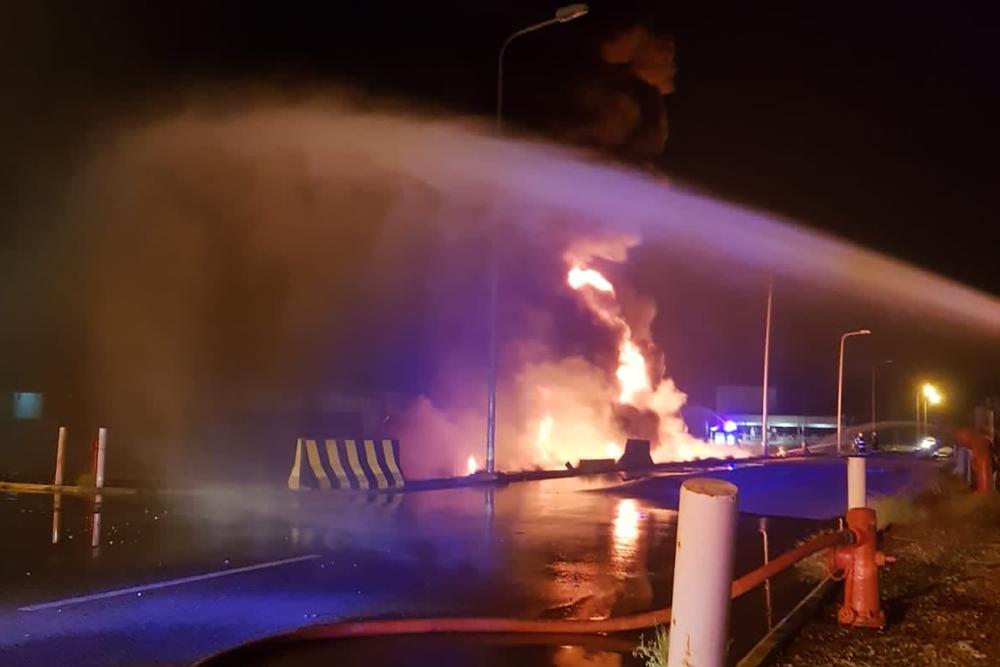Yemen’s Houthi rebels unleashed a barrage of drone and missile strikes on Saudi Arabia that targeted key facilities including natural gas and desalination plants early Sunday, Saudi state-run media reported, temporarily cutting oil production at one site.
The pre-dawn salvo marked the latest escalation in the rebels’ attacks on the kingdom as the war in Yemen rages into its eighth year and peace talks stall.
The attacks did not cause casualties, the Saudi-led military coalition fighting in Yemen said, but damaged nearby civilian vehicles and homes. In a separate incident, the coalition also said it destroyed a remotely piloted boat packed with explosives dispatched by the Houthis in the busy southern Red Sea.
Hours after oil giant Aramco’s CEO told reporters the attacks had no impact on oil supplies, the energy ministry acknowledged that a drone strike targeting the Yanbu Aramco Sinopec Refining Company caused “a temporary reduction in the refinery’s production.”
The disruption, coming as oil prices spike in an already-tight energy market, “will be compensated for from the inventory,” the ministry said in a statement, without elaborating.
The assaults came as Saudi Arabia’s state-backed Aramco, the world’s largest oil company, announced its profits surged 124% in 2021 to $110 billion, a jump fueled by renewed anxieties about global supply shortages and soaring oil prices.
Aramco, also known as the Saudi Arabian Oil Co., released its annual earnings after weeks of intense volatility in energy markets triggered by Russia’s invasion of Ukraine. Punitive sanctions on Russia, among the world’s largest exporters of crude and petroleum products, have added turmoil to the market.
The international oil benchmark Brent crude spiked over $107 on Sunday after nearly hitting a peak of $140 earlier this month. Saudi Arabia and the United Arab Emirates have so far resisted Western appeals to increase oil production to offset the loss of Russian oil as gasoline prices skyrocket.
Brig. Yehia Sarie, a spokesman for Yemen’s Iran-backed Houthis, said the rebels had launched “a wide and large military operation,” firing ballistic missiles and bomb-laden drones at Aramco facilities and other “sensitive targets.”
He described the assault as retaliation for the Saudi-led “aggression and blockade” that has turned much of Yemen into a wasteland.
The Saudi-led military coalition said aerial strikes targeted a range of facilities: an Aramco liquified gas plant and petrochemicals complex in the Red Sea port of Yanbu, a power station in the country’s southwest, a desalination facility in Al-Shaqeeq on the Red Sea coast, an Aramco oil facility in the southern border town of Jizan and a gas station in the southern city of Khamis Mushait.
The extent of damage on Saudi infrastructure and energy facilities remained unclear, and the ministry said only the Yanbu refinery saw a temporary drop in output. A joint venture between Aramco and China, the $10 billion Yanbu Aramco Sinopec Refining Company on the Red Sea pumps 400,000 barrels of oil a day.
The official Saudi Press Agency posted photos of firetrucks dousing leaping flames with water and a trail of rubble wrought by shrapnel that crashed through ceilings and pocked apartment walls. Other images showed wrecked cars and giant craters in the ground.
The barrage comes days after the Saudi-based Gulf Cooperation Council said it invited Yemen’s warring sides for talks in Riyadh aimed at ending the war — an offer dismissed out of hand by the Houthis, who demanded that negotiations take place in a “neutral” country.
The U.N. special envoy for Yemen, Hans Grundberg, met over the weekend with the chief Houthi negotiator in Oman’s capital of Muscat to discuss “a possible truce during the holy month of Ramadan,” expected to start in early April, the U.N. mission said on Sunday.
Peace talks have floundered since the Houthis have tried to capture oil-rich Marib, one of the last remaining strongholds of the Saudi-backed Yemeni government in the country’s north.
Yemen’s brutal war erupted in 2014, after the Iran-backed Houthis seized the country’s capital, Sanaa. Saudi Arabia and other Arab states launched a devastating air campaign to dislodge the Houthis and restore the internationally recognized government.
But years later, the war has settled into a bloody stalemate and created one of the worst humanitarian crises in the world.
Coalition airstrikes have decimated infrastructure and struck civilian targets in Yemen like hospitals, telecommunications centers and wedding parties, drawing widespread international criticism.
Repeated Houthi cross-border attacks targeting the kingdom’s key oil refineries have rattled world energy markets and raised the risk of disruptions to output at Aramco sites.
As part of its 2021 report, Aramco said it stuck to its promise of paying quarterly dividends of $18.75 billion — $75 billion last year — due to commitments the company made to shareholders in the run-up to its initial public offering. Nearly all of the dividend money goes to the Saudi government.
Despite Saudi Crown Prince Mohammed bin Salman’s increasing efforts to diversify the Saudi economy away from oil, the kingdom remains heavily dependent on oil exports to fuel government spending.
The low oil prices of recent years have stung Aramco, forcing the kingdom to scale back its spending on projects and subsidies. But riding on its 2021 income surge and high oil prices, Aramco said on Sunday it expects to raise its capital expenditure to between $40 and $50 billion this year to meet growing energy demand, a sizable increase from last year’s spending of $31.9 billion.
“Although economic conditions have improved considerably, the outlook remains uncertain due to various macro-economic and geopolitical factors,” said Aramco President and CEO Amin H. Nasser.
Aramco shares were up over 3% on Sunday to trade around 43.20 riyals ($11.50) a share on Riyadh’s Tadawul stock exchange.



